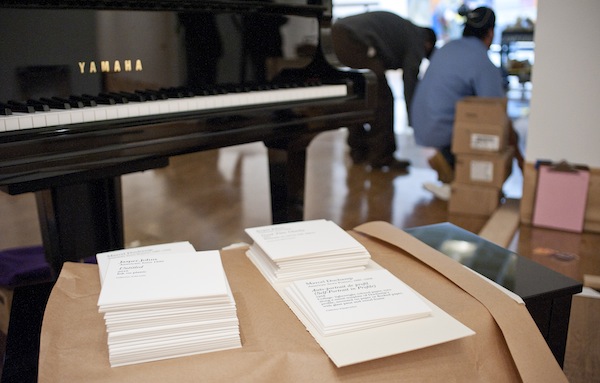
Art Meets Technology: The Soundscape of Dancing around the Bride
By Jaime Bramble Schell, Philadelphia Museum of Art
With visual art, music, and dance all coming together in the Philadelphia Museum of Art’s Dancing around the Bride: Cage, Cunningham, Johns, Rauschenberg, and Duchamp—generously supported by the John S. and James L. Knight Foundation—a visit to the exhibition galleries becomes a true multi-sensory experience. It is a total immersion into the intersecting worlds of these five artists, presenting their creative exchanges of the postwar era as if unfolding in the very moment. Helping to make it all possible behind the scenes, however, is state-of-the-art technology more often associated with Broadway than with a museum.
A Disklavier piano in the Dorrance Galleries. Photo by Constance Mensh.
Sound is critical to embracing the spirits of the artists featured in this show—particularly of composer John Cage and choreographer Merce Cunningham. With that in mind, curators Carlos Basualdo and Erica Battle, as well as Paris-based artist and exhibition orchestrator Philippe Parreno turned to a team of sound professionals including sound designer Nicolas Becker of HAL and sound system designer Duncan Edwards of Audio Design International. Together, they created a soundscape that integrates and distributes both pre-recorded and live sound on 43 speakers throughout the exhibition. Moving endlessly throughout the space, the soundscape is powered by Meyer Sound Lab’s D-Mitri, the same sound system that has been used in countless productions including Spiderman, The Lion King, Les Miserables, Cirque de Soleil, the 2008 Beijing Olympics, and in theme parks such as Disneyland in Anaheim and Opryland.
In Dancing around the Bride, the soundscape is further enhanced by two Yamaha Disklavier pianos, one situated in the exhibition galleries and the other in the Museum’s Great Stair Hall. Disklaviers are unique because, unlike player pianos, they are computer-driven performance reproduction systems, able to record the subtlety of each hammer strike of the performer, catching even the slightest stutter or faintest note. Acclaimed pianist Margaret Leng Tan recorded two John Cage compositions on these Disklavier pianos—Chess Pieces (1944) and Music for Marcel Duchamp (1947)—which now echo, like ghosts, through the Great Stair Hall and Dorrance Galleries.
Other sound components of the show include additional recordings of John Cage’s music, previously recorded outdoor sounds, and live outdoor sounds captured daily using microphones that pick up sound from the streets just outside the Museum (an element that proved essential in any performance of Cage’s “silent” piece 4’33”, which relies on environmental sounds over instrumentation). Parreno also contributed a sound piece titled How Can We Know the Dancer From the Dance? (2012), which plays back audio recordings of the former Merce Cunningham dancers, enabling their movements, footsteps, shuffles, and breathing to travel across the 28 x 32 foot dance floor that has been turned into a speaker with additional high-tech equipment.
All of this together creates a setting that, unlike many museum exhibitions, allows visitors to have different experiences at different times. Each visitor will have their own unique moment in the show. This confluence of art and life was of great importance to Cage, Cunningham, Johns, Rauschenberg, and Duchamp, and is at the heart of Dancing around the Bride.
Dancing around the Bride: Cage, Cunningham, Johns, Rauschenberg, and Duchamp opens to the public today and continues through January 21, 2013 at the Philadelphia Museum of Art, Benjamin Franklin Parkway at 26th Street, (215) 763-8100, philamuseum.org. .
Recent Content
-
Artsarticle ·
-
Artsarticle ·
-
Artsarticle ·

